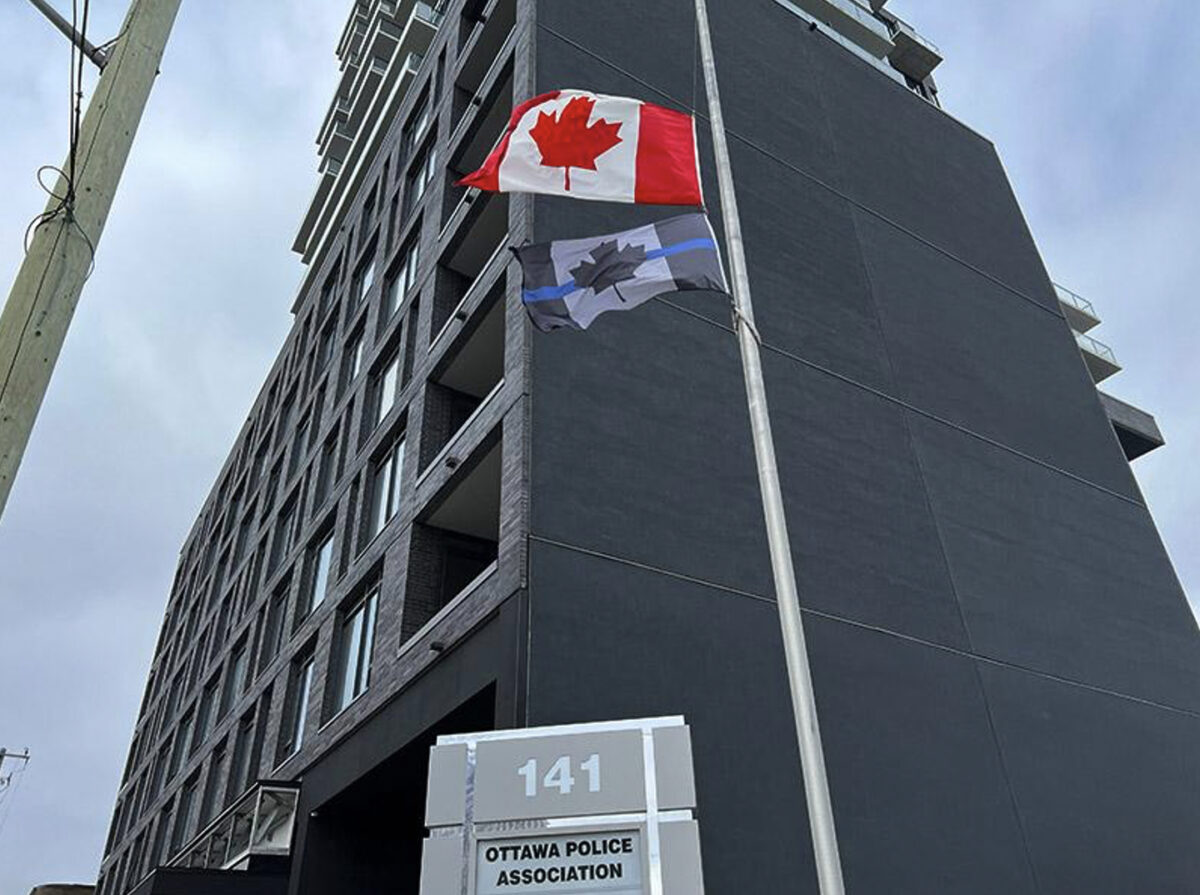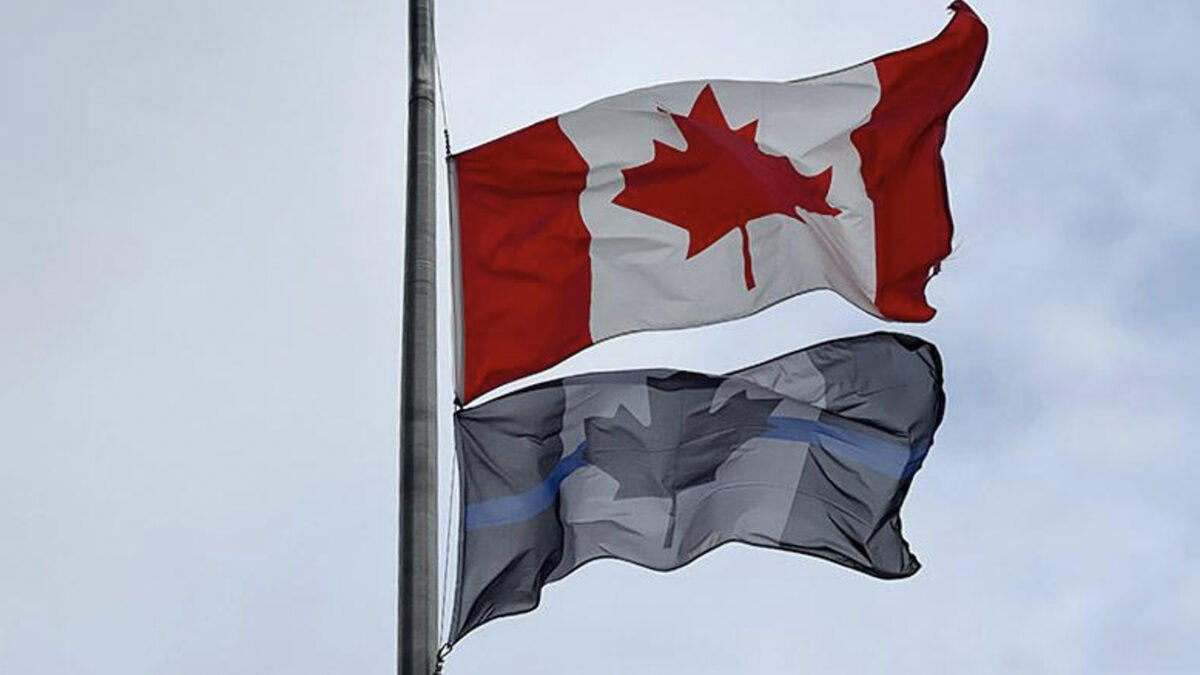The president of the Ottawa Police Association says the group will continue to use the “thin blue line” sign to signal solidarity among officers despite backlash from city officials and advocacy groups that see it as a symbol of racism.
The organization came under fire after the emblem was seen on hockey jerseys during a March 10 charity hockey game between members of the Ottawa Police Service and the Ottawa Fire Service.
Current members of the OPS wore the jerseys, which were provided by the OPA.
The “thin blue line” symbol is a variation of the Canadian flag that features a black maple leaf with a blue line intersecting the leaf and the rest of the flag horizontally. Advocates say the emblem is a show of support for fallen officers and for members of the police force as a whole.
But the symbol has become embroiled in controversy in recent years. Critics say it denotes racism, white supremacy and police brutality given the fact that its popularity has surged in the wake of heated political protests in response to high-profile cases of police brutality towards Black citizens.
‘We’re really actually not getting that much backlash. For every upset person, I’m getting 10 additional emails thanking me for speaking out and educating the public on what (the symbol) means to us.’
— Matthew Cox, president, Ottawa Police Association
American versions of the flag were flown at the Unite the Right rally in 2017. It then became the unofficial flag of the so-called Blue Lives Matter movement in opposition to the Black Lives Matter protests in 2020 and 2021 following the murder of George Floyd by Minneapolis police.
In Canada, far-right groups that occupied Ottawa during the so-called Freedom Convoy protests of January-February 2022 flew the Canadian variation of the “thin blue line” flag in front of the Parliament Buildings.
OPA president Matthew Cox has denounced the assertion that there is a connection between far-right ideologies and the “thin blue line”.

“What it symbolizes to me is very simple,” said Cox. “It is to remember and honour our fallen members who have died in the line of duty.”
Cox acknowledged that “the far right” may have “tried to hijack” the symbol for its own purposes. But he added that “the far left” won’t accept the OPA’s argument that the symbol is purely about pride in policing.
According to the OPA website, the association represents more than 2,100 uniform and civilian members employed by the Ottawa Police Service. The association states that its objectives “are to unite fraternally and promote the mutual interest of its members; to uphold the honour of the police profession and to provide support and financial assistance in accordance with the OPA bylaws.”
In addition to the hockey jerseys, the association shares the symbol on Twitter and on a flag that is currently displayed outside its downtown Ottawa headquarters on Catherine Street.
But anti-racism activist groups aren’t the only ones condemning the OPA’s use of the symbol citing its correlation with far-right movements. Policing institutions across Canada, including the RCMP in 2020 and the Ottawa Police Service in 2021, have banned the use of the symbol by officers on duty.
Former city councillor Diane Deans, who served as chair of the Ottawa Police Services Board during her time on city council, released a statement objecting to the OPA’s unfurling of its “thin blue line” flag in 2021.
“I…ask that the OPA consider the unintended message (the symbol) communicates to some Ottawa residents, with its perceived affiliation with damaging ideologies,” Deans wrote at the time.
The OPA’s choice to use the symbol has also prompted condemnation by advocacy groups such as Horizon Ottawa, a municipal government watchdog that campaigns for social justice and other causes. Horizon Ottawa spokesperson Sam Hersh insisted that the symbolism of the “thin blue line” is clear.
“It’s a slap in the face to a lot of communities after what people experienced after the convoy,” said Hersh. “This particular symbol is a hateful, extremist symbol.”
Somerset Coun. Ariel Troster also spoke out against the OPA after publicly released photos of the charity hockey game showed OPS officers wearing the “thin blue line” jerseys.
‘It’s a slap in the face to a lot of communities after what people experienced after the convoy. This particular symbol is a hateful, extremist symbol.’
— Sam Hersh, spokesperson, Horizon Ottawa
“If the Ottawa police really do want to reach out and build trust with the community, now is the time for healing,” Troster stated in a tweet. “One of the ways they can do that is for members to stop displaying that particular symbol.”
Troster’s stance on the matter led to obscene harassment online by individuals espousing far-right viewpoints.
Ottawa Mayor Mark Sutcliffe also released a statement about the controversy, stating: “It’s clear, that because of recent events, how the (thin blue line) is interpreted by some members of the community has evolved.”
Hersh said Sutcliffe’s statement was a “word salad” and criticized the mayor’s centrist take on the matter, as well as his silence about the vile online abuse Troster faced for her comments.
When asked if the OPA would reconsider its use of the “thin blue line” due to the backlash, Cox emphatically said no.
“We’re really actually not getting that much backlash,” said Cox. “For every upset person, I’m getting 10 additional emails thanking me for speaking out and educating the public on what (the symbol) means to us.”




